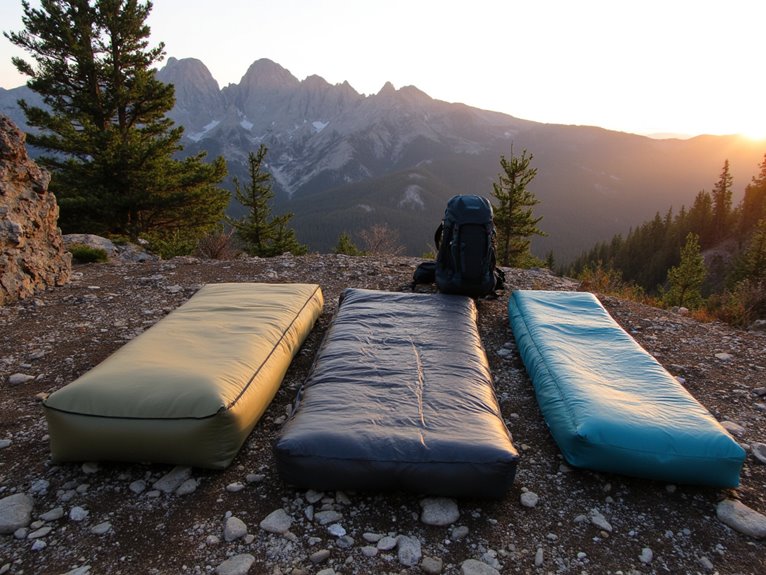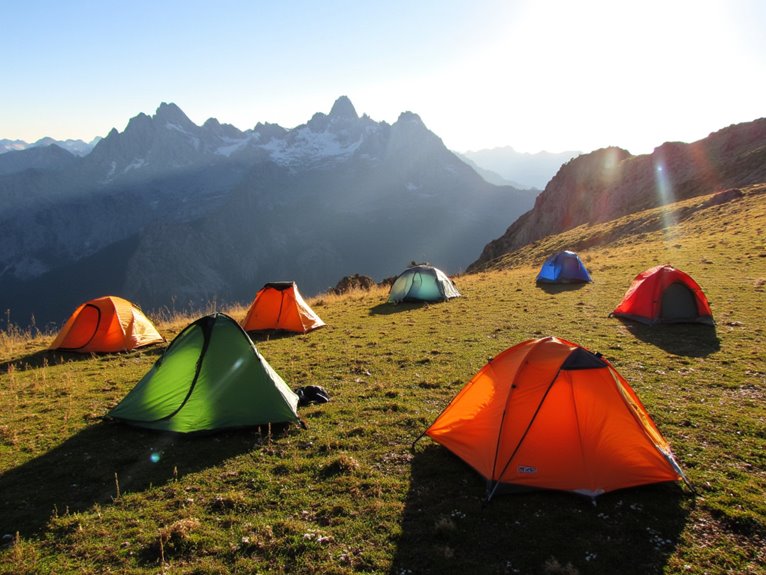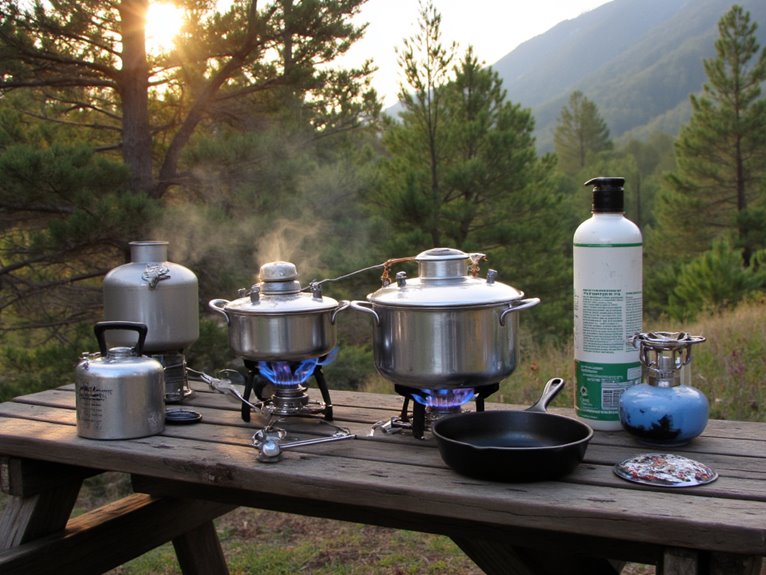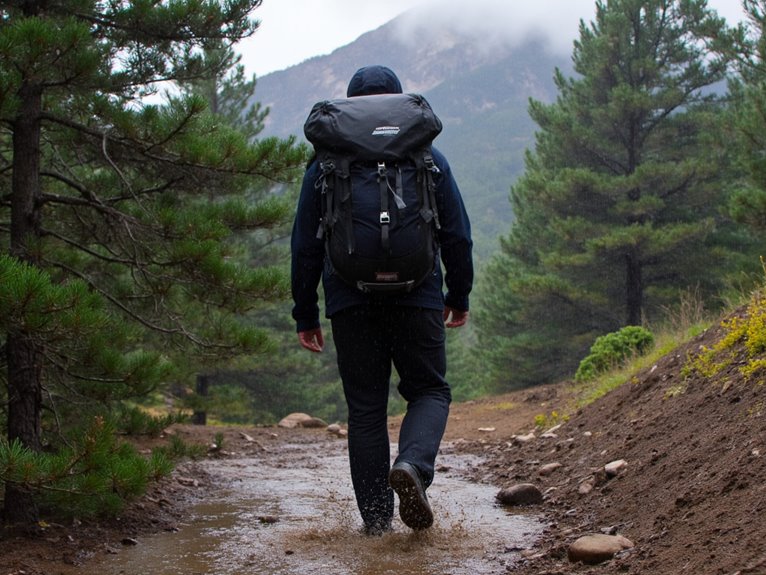How to Choose the Right Sleeping Pad for Backpacking
You’ll need to balance four key factors when selecting a backpacking sleeping pad: R-value for insulation (1.0 for summer, 4.4-5.2 for three-season use), weight versus comfort (air pads at 12-20 ounces offer the best weight-to-comfort ratio), your sleep position (side sleepers require 4+ inches thickness), and durability needs (closed-cell foam lasts longest, air pads offer superior comfort but need careful handling). Understanding these specifications will help you discover which pad type best matches your specific backpacking adventures.
We are supported by our audience. When you purchase through links on our site, we may earn an affiliate commission, at no extra cost for you. Learn more. Last update on 5th December 2025 / Images from Amazon Product Advertising API.
Notable Insights
- Choose pad type based on priorities: air pads for weight savings, self-inflating for cold weather, foam for durability and budget.
- Select R-value matching conditions: 1.0-3.0 for summer, 4.4-5.2 for three-season, 7.0+ for winter mountaineering and extreme cold.
- Consider thickness requirements: side sleepers need 4+ inches for pressure relief, stomach sleepers can use thinner profiles.
- Balance budget with performance: entry-level foam pads ($30-50), mid-range inflatables ($100-180), premium options ($200+) for superior features.
- Factor in durability and maintenance: closed-cell foam lasts longest, air pads require careful handling and repair kit preparation.
Understanding Different Types of Sleeping Pads
When selecting a sleeping pad for backpacking, you’ll encounter five primary types, each engineered with distinct advantages and trade-offs.
Air pads offer the lightest weight solution, typically weighing 12-20 ounces across standard pad sizes. They’re adjustable but produce noise during movement.
Self-inflating pads combine air chambers with internal foam, delivering superior insulation and support for cold-weather usage scenarios.
Self-inflating pads excel in cold conditions by combining air chambers with foam insulation for optimal warmth and structural support.
Closed-cell foam pads provide maximum durability and budget-friendly pricing, though they sacrifice comfort due to reduced thickness.
Hybrid pads merge multiple materials for enhanced performance characteristics.
Inflatable foam pads utilize foam insulation with inflatable support chambers, balancing warmth and comfort.
For effective cushioning and pressure point relief, choose pads with at least 2 inches of thickness when tackling challenging terrains.
Your choice depends on specific usage scenarios, weight requirements, and comfort preferences for your backpacking adventures.
Evaluating Comfort Features and Support
After selecting your pad type, comfort and support features become the determining factors in sleep quality during multi-day trips. Pad thickness benefits directly correlate with pressure point relief, especially for side sleepers requiring 4+ inches of loft.
The Therm-a-Rest NeoLoft’s 4.6-inch thickness exemplifies ideal cushioning. Built-in side rails prevent rolling while maintaining sleep position stability.
Your sleeping position preferences determine thickness requirements. Side sleepers need maximum cushioning, while stomach sleepers perform better with thinner profiles to avoid neck strain.
Stretch knit polyester fabrics conform to body contours, enhancing comfort across all positions. Support features include stable construction materials and edge rails for consistent positioning.
Air pads offer customizable firmness adjustment. However, some reflective insulation materials create noise during movement, potentially disrupting sleep quality.
Memory foam variants provide superior pressure relief through high-density foam construction, making them particularly beneficial for extended backpacking trips where recovery sleep is essential.
Insulation Properties and R-Value Considerations
When you’re selecting a sleeping pad, understanding insulation properties becomes critical for maintaining warmth during overnight trips.
The R-value serves as your primary metric for comparing thermal resistance across different pad models, with ratings typically ranging from 1.0 for summer conditions to 7.0+ for winter expeditions.
Your choice directly impacts sleep quality since inadequate insulation leads to conductive heat loss through ground contact, while excessive insulation adds unnecessary weight and bulk to your pack.
For three-season backpacking, most ultralight pads offer R-values between 4.4 and 5.2 for excellent insulation, though specialized models like TREKOLOGY’s pad feature a 7.2 R-value for year-round performance in the harshest conditions.
Understanding R-Value Ratings
The R-value rating serves as your most critical metric for evaluating sleeping pad insulation performance. This standardized scale ranges from 1 to 7, measuring thermal resistance against ground heat loss. Higher numbers indicate superior insulation properties.
Current R value trends show technological advances enabling lightweight pads with exceptional warmth ratings. Don’t fall for insulation myths claiming all foam pads are inferior—construction matters more than material type alone.
| R-Value Range | Recommended Use |
|---|---|
| 1.0-2.0 | Summer camping only |
| 2.1-3.5 | Three-season adventures |
| 3.6-4.5 | Cold weather camping |
| 4.6-6.0 | Winter mountaineering |
| 6.0+ | Extreme arctic conditions |
You can stack multiple pads by adding their R-values together. A 2.5 R-value pad combined with a 1.5 foam pad equals 4.0 total insulation—perfect for extending your camping season affordably.
Seasonal Insulation Requirements
Your insulation needs shift dramatically based on when you’re hitting the trail, and choosing the wrong R-value for your season can turn a great adventure into a miserable experience.
Summer camping requires R-values between 1-2, providing minimal insulation for warm conditions. These lightweight options excel when temperature variations stay above 50°F.
Cool weather demands R-values of 2.0-3.9. Cold conditions need substantial insulation with R-values from 4.0-5.4.
Winter camping requires R-values of 5.5 or higher for extreme cold protection.
Your seasonal preferences should dictate pad selection.
Spring and fall backpackers benefit from mid-range insulation that adapts to unpredictable weather.
Winter enthusiasts often stack pads—combining closed-cell foam under air pads—to boost total R-value. This layering technique provides customizable warmth for changing conditions.
Durability Factors and Maintenance Requirements
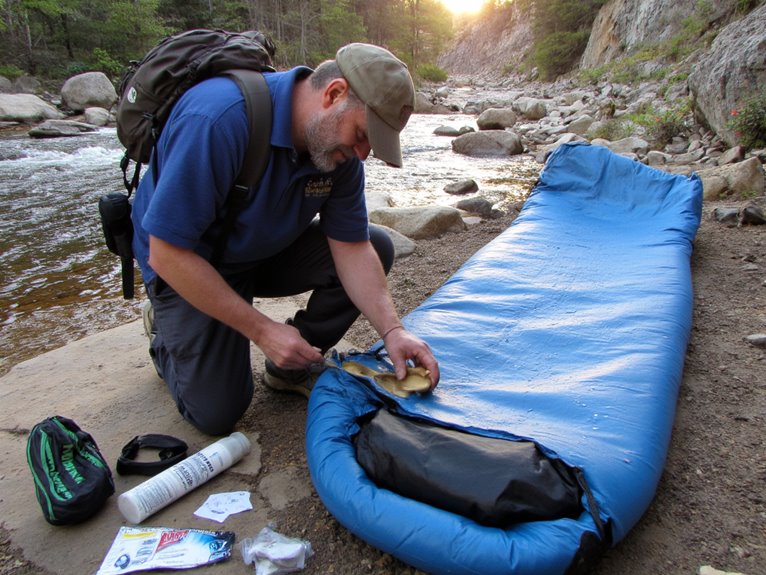
Your sleeping pad’s longevity depends on material strength and construction quality, with 40D nylon fabrics and reinforced seams providing superior resistance to abrasion and failure compared to thinner alternatives.
You’ll need a thorough repair kit containing patches, adhesive, and valve tools to address field punctures that could otherwise end your trip prematurely.
Proper cleaning and storage practices prevent mold growth and material degradation, requiring you to dry your pad completely before packing it away in moisture-free environments.
Expected lifespan varies significantly by pad type, with foam pads typically lasting 3-5 years while air pads generally provide 2-4 years of reliable service before showing signs of inflation retention loss or decreased insulation performance.
Material Strength and Construction
| Material Type | Durability Rating | Maintenance Level |
|---|---|---|
| Closed-cell foam | Highest | Minimal |
| Self-inflating | Moderate | Medium |
| Air pads | Variable | High |
Thicker construction enhances longevity but increases pack weight and bulk.
Repair Kit Essentials
Every backpacker’s repair kit should contain five essential components that address the most common sleeping pad failures in the field.
You’ll need a multi-tool with knife, scissors, and pliers for cutting and preparation. Duct tape provides versatile temporary sealing capabilities. Material-specific adhesive patches create durable hole repairs. Outdoor-grade glue like Seam Grip WP guarantees strong patch bonding. Include needle and thread for fabric tear repairs.
Your repair kit supplies must include leak detection tools. Mix soap and water to create bubbles that pinpoint small leaks. Use rubbing alcohol wipes to clean patch areas, improving adhesion effectiveness. A marker helps you circle leak locations for accurate patch application.
Proper patch application requires thorough cleaning and drying before applying patches. Hold pressure for thirty seconds minimum to guarantee proper adhesive bonding and weather-resistant seals.
Cleaning and Storage
Beyond field repairs, proper cleaning and storage practices directly impact your sleeping pad’s lifespan and performance reliability.
Effective cleaning methods prevent material degradation and maintain insulation integrity. Storage conditions determine whether your pad survives multiple seasons or fails prematurely.
Essential Cleaning and Storage Protocols:
- Surface Cleaning: Use lukewarm water with mild detergent and a soft cloth. Avoid harsh chemicals that compromise material integrity.
- Valve Protection: Keep water away from valves during cleaning to prevent internal damage and air leak development.
- Complete Drying: Guarantee total moisture removal before storage to prevent mold growth and material breakdown.
- Controlled Environment: Store in well-ventilated, shaded areas within waterproof covers to shield from UV damage and debris accumulation.
Seasonal cleaning schedules maintain hygiene standards while preventing oil buildup that attracts dirt and reduces material performance.
Budget Analysis and Value Assessment
When evaluating sleeping pads for backpacking, your budget directly impacts the performance features you’ll receive, with clear tiers emerging across the $30 to $200+ price spectrum.
Entry-level closed-cell foam pads ($30-$50) offer exceptional durability but sacrifice comfort and insulation. Mid-range inflatable options ($100-$180) balance weight, comfort, and thermal efficiency effectively.
Budget-conscious backpackers face a clear trade-off between durability and comfort when selecting sleeping pads.
Cost performance analysis reveals that premium pads ($200+) deliver superior warmth-to-weight ratios and packability through advanced materials.
Price comparison shows ultralight models justify higher costs with features like enhanced R-values and quiet surface materials.
Maximize value by matching specifications to your specific needs rather than buying the most expensive option.
Consider seasonal discounts, multi-season versatility, and combining pad types to optimize your investment while maintaining performance standards. Higher-quality sleeping pads feature 40D-50D nylon with TPU coatings that provide greater outdoor resistance and justify their premium pricing for serious backpackers.
Matching Pad Features to Your Specific Backpacking Needs
Having determined your budget range, you’ll need to match specific pad features to your backpacking style and environmental conditions.
Your sleeping habits, trip duration, and expected weather conditions directly influence which specifications matter most for your gear selection.
Consider these key matching factors:
- Temperature Rating vs. R-Value – Match R-values above 4.7 for cold-weather trips; combine pads for extreme conditions.
- Body Position Requirements – Side sleepers need 4.6-inch pad thickness minimum to prevent pressure points and discomfort.
- Trip Length vs. Durability – Select 50-denier fabrics for extended expeditions; lighter materials suffice for weekend trips.
- Pack Weight Priorities – Ultralight pads sacrifice insulation; balance weight savings against comfort needs based on terrain difficulty.
Match insulation material to your warmth-to-weight requirements while considering your typical camping conditions.
Look for pads with egg-shaped air cells that provide targeted support for your back and neck, particularly beneficial if you’re a side sleeper requiring enhanced comfort features.

